Embossing/debossing may also be used for more than just aesthetic appeal. It can also be used to provide practicality – particularly for the sight impaired. Raised Braille images, for example, have been required on all food products in the UK and are starting to appear on food and wine labels in the USA. Embossing can also be used to add 2D security features and holographic effects.
In the label and packaging sectors embossing tools are used to shape/set the surface of the label or card substrate to create either a raised (embossed) or recessed (de-bossed) image design, decoration, lettering or pattern that will enhance and elevate the quality and standard of the label or pack. Quite simply, embossing is used in the world of labels and packaging for a wide range of decorative and other reasons, including:
-
The creation of a luxury look and feel to the product
-
To provide a tactile and more pleasing surface texture
-
To attract attention and draw the consumer's eye or hand to the product
-
To enhance text or graphics to make a design, pattern or logo stand-out
-
To add elegance and sensuality to the label or packaging
-
To create a higher profile image or identity for the labeled or packaged product
-
To provide a relatively inexpensive way to enhance a label or pack's look and feel
-
To meet a requirement for Braille on labels or packs that may be used by the blind
-
To add a more expensive or added-value identity to products
-
To provide anti-counterfeiting or security features
-
To add dimension or ‘realism’ to flat products.
These various types of embossing effects are created by applying a texture, image, text or graphics to a label or pack substrate by raising or recessing its surface at varied angles. Frequently used with hot or cold foiling, embossing or de-bossing effectively alters the surface of a label or other substrate by creating a three-dimensional raised or sunken design or image, most commonly achieved by the use of two dies: one raised (male) and one counterforce (female), which may either be flat or rotary.
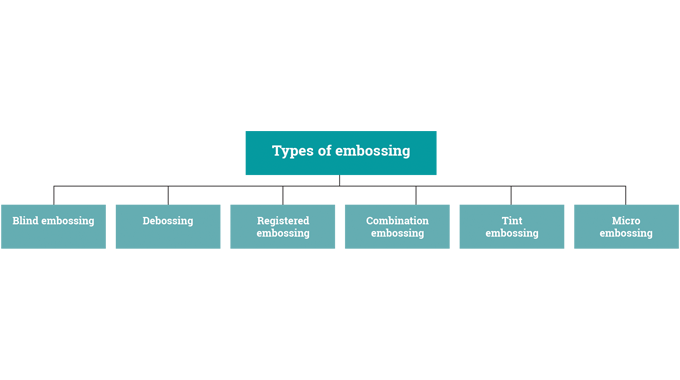
Debossing. In this process, the substrate surface is recessed below paper level instead of raised as in conventional embossing (Figure 5.3). De-bossing uses the same techniques as embossing to create the necessary indentation, except that the process involves the application of pressure to the face side of the substrate, forcing the material downwards into the female die so as to create the recessed profile. This can be as emphatic or delicate as the graphics or words dictate, and careful choice of substrate (avoiding bright whites and very smooth materials) will undoubtedly enhance the effect.
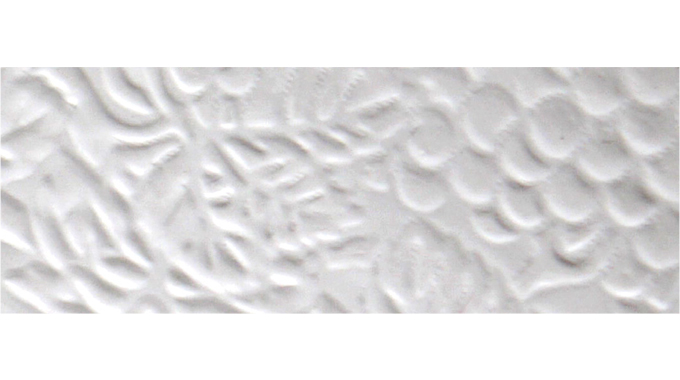
Combination embossing. Combination embossing in the same pass refers to the embossing of a foil stamped image and can be used to add even more interest to a gold or silver glow.
The process of combination foil stamping and embossing in the same pass with one die/tool can only be done with single combination brass flat dies . not with cylinders. The die has a ‘special edge’ around the image area to ensure that the foil substrate separates the foil layers evenly from the carrier with each combination impression cycle (see Figure 5.6). An example of a substrate which has been blind embossed (right) and also combination foil embossed (left) can be seen in Figure 5.5.
It is also possible to run inline one cylinder station with a foiling die and run another cylinder with an embossing die. That is two cylinders, rather than using a flat combined foiling/embossing die. This enables the press to be run at higher rotary printing and converting speeds.
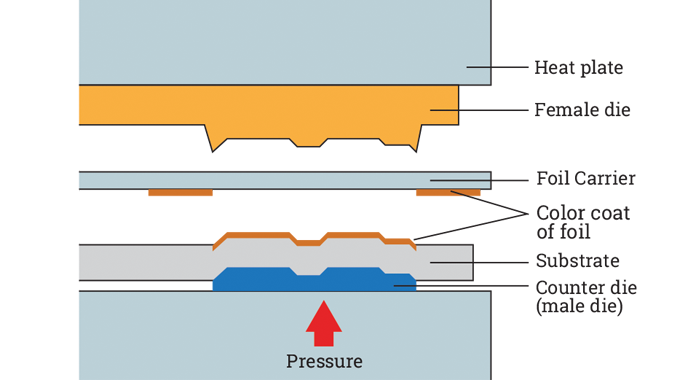
Registered embossing. This is an embossed image that exactly registers to a prior printed image, design or text. The printed image area is embossed to give an attractive or exciting raised look, as can be seen in the detail from the award winning Dream No 7 wine label (Figure 5.4) produced by Collotype Labels North America Wines and Spirits. Embossed labels can work well in combination with four-color process printing.
Depending on the specific customer requirements and specifications, the bevel can stay inside the printed image or go outside it.

Combination embossing. Combination embossing in the same pass refers to the embossing of a foil stamped image and can be used to add even more interest to a gold or silver glow.
The process of combination foil stamping and embossing in the same pass with one die/tool can only be done with single combination brass flat dies . not with cylinders. The die has a ‘special edge’ around the image area to ensure that the foil substrate separates the foil layers evenly from the carrier with each combination impression cycle (see Figure 5.6). An example of a substrate which has been blind embossed (right) and also combination foil embossed (left) can be seen in Figure 5.5.
It is also possible to run inline one cylinder station with a foiling die and run another cylinder with an embossing die. That is two cylinders, rather than using a flat combined foiling/embossing die. This enables the press to be run at higher rotary printing and converting speeds.
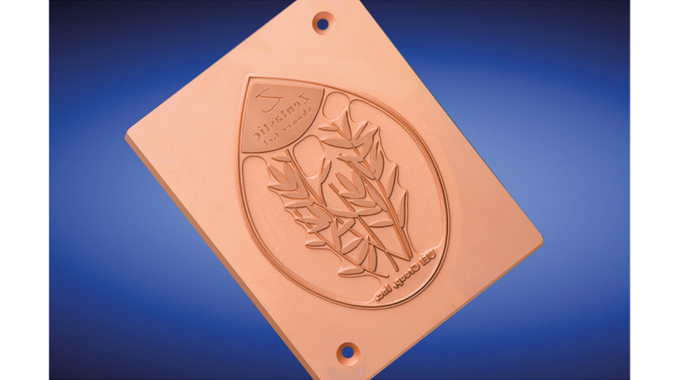

Combinations of foiling and embossing are still carried out in label decoration, but they were historically used extensively for the manufacture of ‘seals’ both self-adhesive and none self-adhesive applications. Seals provided a superb and unique method of product decoration particularly on high weight metalized substrates.
Tint Embossing. A relatively new method of embossing in which a tint foil is used in the embossing process. The methodology is the same as other types of embossing but the technique has become increasingly in demand. For tint embossing it is generally best to use white stock because the tint foils are translucent.
Micro embossing and debossing. This is where the effect is achieved with minimal depth but using intricate and complex designs. The process has become increasingly attractive in security applications such as event ticketing, anti-counterfeiting and legal documents. Indeed, embossing may be used for a wide range of security purposes. Embossed seals or symbols of authenticity add security features to labels, government forms, legal documents, and corporate papers. Having said that, security embossing today is perhaps considered as an older form of document or label security, as more alternatives in analogue and digital print processes, origination and pre-press, foiling, etc., continue to be developed.
Glazing. This refers to a polished emboss. It is not used in the rotary/narrow-web industry because in order to undertake glazing it is necessary to slow the dwell and ‘be on impression’ for a period of time.
Nevertheless, glazing is a popular technique in some print sectors, particularly when used on dark colored stock. The heat and the pressure when pressing the die are increased substantially. This adds shine to the surface. If a very high temperature is used, light color papers can be scorched to change the paper color. This provides for great contrasting designs if done properly.
PREPARATION OF ARTWORK FOR EMBOSSING
As can be seen from the above summaries, there are many types of embossing to choose from depending on the embossing design created, the nature and type of substrate being used, the embossing effect required, whether the embossing is blind and raised or de-bossed and recessed, whether it is registered to prior printing or foiling.
To be able to produce the ultimate in embossing results for any of different types of embossing it is essential that everyone in the production chain understands exactly what is required and the effects desired . from the designer through to the engraver and on to the printer and converter. Clear communication, understood by all, will undoubtedly help to ensure that a quality product and finished image will be produced.
There are a number of aspects to bear in mind when preparing artwork for embossing, including:
-
When creating digital files for embossing use a file format agreed with the engraver, most usually Adobe® Illustrator although others may also be accepted. Only send the tooling artwork, not the print files
-
Provide artwork 100% actual size, fully stepped out and saved at 600 dpi or higher
-
Artwork should be Vector art and solid line art supplied without screens or tints. Do not include masks. Grayscale artwork will not provide optimum results
-
Convert all type to outlines. Avoid too many fine details and tiny criss-cross lines. Aim to keep the design as uncluttered and bold as possible. All objects should be ‘filled’
-
When using lettering in the design use sans serif fonts and space them out so that there is enough space between each letter to allow for the embossing effect
-
The size of the artwork may need to be increased slightly to compensate for the added dimension. Check with the engraver
-
Where multi-level embossing is required it may be advisable to use color coding to indicate the various levels. Again, check with the engraver
-
Try to keep the image area at least .25 inches away from the edge of the web or an oversized sheet to avoid puckering or wrinkling. If the embossing is being done on a finished project, keep a .5 margin.
The artwork should indicate:
-
The web direction/leading edge
-
The die-cut line (if applicable).
Once the digital files have been created they should be sent to the engraver (saved to a CD) via conventional couriers, together with a completed order form for the specific engraved tool.
THE EMBOSSING PROCESS
The process of embossing is a relatively simple and cost effective means to raise or recess some areas of a paper, carton board or other surface so as to enhance its look and feel. However, there are a number of things that need to be attended to and reviewed in the creation of a successful embossing project.
These considerations include the method of embossing (flat, segmented, rotary), the embossing die materials (magnesium, steel, brass, copper, etc), the structure of the dies to be used, the die etching or engraving process, the type of surface to be embossed (paper, card, foil, etc) the creation of the necessary artwork and the particular embossing details. Each of these factors are discussed here, the choice of method generally being governed by the type of label required, the run length and the cost.
Embossing presses or units can take many forms, but in general the operating principle remains the same whether using flatbed, semi-rotary or full rotary. This is shown in Figure 5.7, based on a simple flatbed embossing operation. The choice of method is usually governed by the type of label required, the run length and the cost.
As can be seen, the substrate to be embossed is sandwiched between the male and female dies and pressure is applied so as to force the male relief image into the female recessed image.
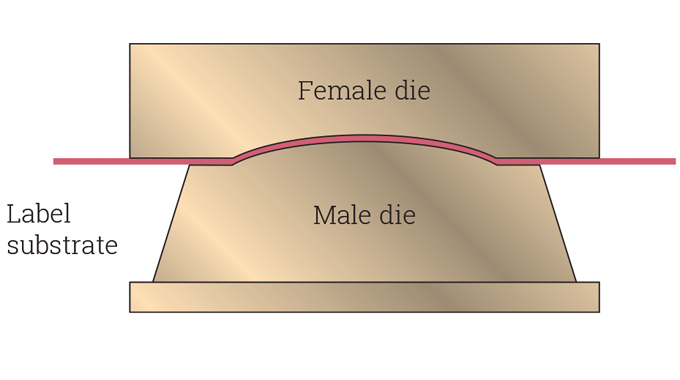
Heat may be used to advantage when embossing - but it is not necessary. The use of a heated die can aid the molding of the substrate fibers during the embossing process, but care must be taken not to apply too much heat, as this will distort the substrate. However, in flat die stamping or combination stamping/embossing heat is necessary to activate the foil release layer.
No ink is used for the actual embossing process but very often the embossed image will lay over the printed area of the label. This will involve close register between the printed image and the embossed image and this is called a ‘registered emboss’. If the embossed image lies in a non-printed area this is called blind embossing’.
Embossing units are available in many sizes, which are usually measured in terms of the maximum amount of pressure that can be applied.
METAL EMBOSSING AND POLYMER DIES
There are four types of metals . steel, magnesium, brass or copper . that are predominately used for the manufacture of embossing dies, with the choice depending on a number of factors such as:
-
the shape and depth of relief of the image
-
the texture to be created
-
nature of material to be embossed
-
perceived productive life of the die
-
requirements specific to product use, e.g. food or pharmaceuticals.
The flatbed and semi-rotary processes use steel, magnesium, copper and brass dies, whereas full rotary embossing generally uses only brass or steel dies. The manufacturing costs of embossing dies can be more, particular when tooling and engraving full rotary male and female brass dies.
These different die materials are reviewed as follows:
Steel dies can be machined, CNC engraved, hardened and ground and are suitable for long running applications and, although they are the most expensive of the embossing die materials, can pay for themselves in terms of reduced downtime. However, they are limited with the type of engraving effects and cannot go as deep. Fine lines can also be a challenge. They can be engraved to fit contoured parts.
Magnesium dies are used for simpler embossing projects that have short runs up to 5,000 impressions on smoother stocks, with designs that are large and uncomplicated. Magnesium also allows for special hand tooling. Magnesium is the softest of the materials used for metal dies and also allows for special hand tooling. They are the least expensive of all dies. However, magnesium dies can be smashed or damage easily and must then be replaced.
Best suited for flatbed use only, they are photomechanically etched. In the manufacturing process, a photo sensitive coating is first applied to the magnesium plate to be imaged. A film negative of the image to be produced is then placed in contact with the plate surface and exposed to a light source, before being photographically developed to produce the image. The plate is then chemically etched to remove the ‘non-image’ area leaving the ‘image’ area in relief.
Being a soft metal, magnesium dies may present problems when using a textured stock. They can pick-up the textured pattern from the paper stock and therefore cause damage to the die.
Brass dies are the most popular of the embossing die materials and is used for both flat and rotary embossing die production. They are very flexible and give the embosser leeway to create fine lines, sculptured images, combo foil stamping and embossing. They are also very good for images requiring extensive hand tooling and can be made by machines or by a semi-photographic process.
Flatbed brass embossing dies (Figure 5.9) are imaged using a CNC digitally driven engraving system. This method applies also to the imaging of rotary dies made from brass or steel. Flatbed brass embossing dies are engraved in the flat, with the engraving head traveling over the die moving through the X and Y axis and rising and falling as the digital data instructs. This method of engraving produces a very fine and detailed image.

Heat may be used to advantage when embossing - but it is not necessary. The use of a heated die can aid the molding of the substrate fibers during the embossing process, but care must be taken not to apply too much heat, as this will distort the substrate. However, in flat die stamping or combination stamping/embossing heat is necessary to activate the foil release layer.
No ink is used for the actual embossing process but very often the embossed image will lay over the printed area of the label. This will involve close register between the printed image and the embossed image and this is called a ‘registered emboss’. If the embossed image lies in a non-printed area this is called blind embossing’.
Embossing units are available in many sizes, which are usually measured in terms of the maximum amount of pressure that can be applied.
METAL EMBOSSING AND POLYMER DIES
There are four types of metals . steel, magnesium, brass or copper . that are predominately used for the manufacture of embossing dies, with the choice depending on a number of factors such as:
-
the shape and depth of relief of the image
-
the texture to be created
-
nature of material to be embossed
-
perceived productive life of the die
-
requirements specific to product use, e.g. food or pharmaceuticals.
The flatbed and semi-rotary processes use steel, magnesium, copper and brass dies, whereas full rotary embossing generally uses only brass or steel dies. The manufacturing costs of embossing dies can be more, particular when tooling and engraving full rotary male and female brass dies.
These different die materials are reviewed as follows:
Steel dies can be machined, CNC engraved, hardened and ground and are suitable for long running applications and, although they are the most expensive of the embossing die materials, can pay for themselves in terms of reduced downtime. However, they are limited with the type of engraving effects and cannot go as deep. Fine lines can also be a challenge. They can be engraved to fit contoured parts.
Magnesium dies are used for simpler embossing projects that have short runs up to 5,000 impressions on smoother stocks, with designs that are large and uncomplicated. Magnesium also allows for special hand tooling. Magnesium is the softest of the materials used for metal dies and also allows for special hand tooling. They are the least expensive of all dies. However, magnesium dies can be smashed or damage easily and must then be replaced.
Best suited for flatbed use only, they are photomechanically etched. In the manufacturing process, a photo sensitive coating is first applied to the magnesium plate to be imaged. A film negative of the image to be produced is then placed in contact with the plate surface and exposed to a light source, before being photographically developed to produce the image. The plate is then chemically etched to remove the ‘non-image’ area leaving the ‘image’ area in relief.
Being a soft metal, magnesium dies may present problems when using a textured stock. They can pick-up the textured pattern from the paper stock and therefore cause damage to the die.
Brass dies are the most popular of the embossing die materials and is used for both flat and rotary embossing die production. They are very flexible and give the embosser leeway to create fine lines, sculptured images, combo foil stamping and embossing. They are also very good for images requiring extensive hand tooling and can be made by machines or by a semi-photographic process.
Flatbed brass embossing dies (Figure 5.9) are imaged using a CNC digitally driven engraving system. This method applies also to the imaging of rotary dies made from brass or steel. Flatbed brass embossing dies are engraved in the flat, with the engraving head traveling over the die moving through the X and Y axis and rising and falling as the digital data instructs. This method of engraving produces a very fine and detailed image.
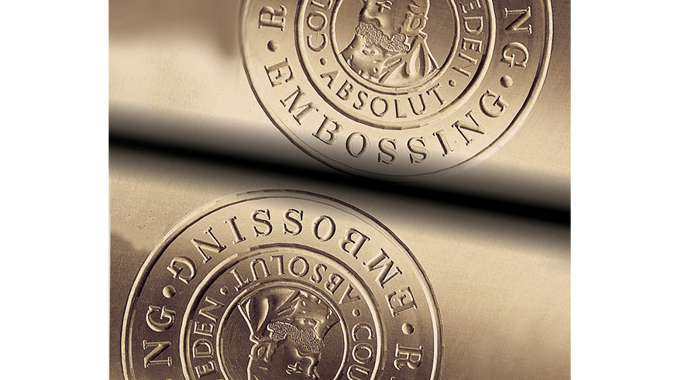


The female die has the required image incised into the surface, whilst the male die has a matching raised image. An offset is applied to one or both images to allow the dies to accommodate the thickness of the material being embossed. This ensures that, when the dies are correctly registered, the material is 'moved' into the cavity on the female die by the raised image on the male, without crushing, cutting or unduly stressing the material being embossed.
As already mentioned, embossing dies are manufactured from a range of materials depending on requirements specific to product use, e.g. food or pharmaceuticals.
Usually steel, brass or aluminium are used, but there are a range of other materials that may be chosen based on the specific list of criteria.
REGISTRATION OF MALE AND FEMALE EMBOSSING DIES
As will have beeen evident from Figure 5.11 and the description of how embossing is achieved, there is little margin for error in the registration of male and female dies, which should always be supplied with adjustable timing gears. This enables the dies to be accurately set-up to achieve optimum results.
Of course, the gears only control registration along the web. Registration across the web has to be maintained by other means.
Two methods can be used. The first and less common is to mount the dies into a purpose made frame where cross web positioning of one die relevant to the other can be carefully set-up and maintained.
The second, and more common method, is to produce the dies with a cross-web location ring and groove. These are fitted during manufacture and lock the dies together in correct registration across the web. This is a more popular approach because it removes the requirement for the press operator to be involved in a time consuming and tedious process where errors can have fatal consequences for the dies (and possibly even the press operator). It also enables the dies to be used in non-dedicated cutter stations avoiding the need for costly investment in dedicated embossing units.
MOUNTING AND POSITIONING OF FEMALE DIES ON PRESS
There are three main systems for mounting male/female embossing die sets on a label press.
-
Die sets can be supplied as a complete set pre-registered and mounted as a self-contained embossing unit or cassette.
-
Dies are supplied without cross-web location ring and groove (but with anti-backlash and adjustable gears) for installation into a dedicated embossing unit or cassette on press. These purpose made units have accurate cross-web adjustment and clamping mechanisms to allow the dies to be correctly registered and held for production.
-
Dies are supplied with cross-web location ring and groove and adjustable gears for fitting into a suitable cutter station.
REQUIREMENTS OF REGISTER FOR MALE/FEMALE EMBOSSING
As has already been alluded to above, registration between the male and female dies is critical and the inclusion of adjustable gears and cross-web location ring and groove assist in achieving the very close registration required with male/female die sets.
Clearance between the male and female images is, as a general rule, only a few microns more than the thickness of the material being embossed, depending on the nature of the material and the required emboss. It is evident from this that a small error in registration or small variations in the substrate, liner or adhesive, can cause an uneven emboss, cutting or crushing of the material, or even damage to the dies.
For this reason, it is also important that mounting blocks, bearings and bearing block housings are in good condition, dimensionally accurate and fit together with absolutely minimum clearance. Proofs of the embossing cylinder set should always be provided by a competent engraver.
There are die positioning systems on the market that are used to accurately place embossing dies onto a honeycomb base. These work by using a touch screen as a visual guide on where to place each die on the honeycomb chase, based off of a digital or scanned sheet. A camera moves above the honeycomb work area where the die is to be placed. This displays overlay images, one of the digital file, with the other providing the live image of the chase. As the die is moved under the camera the operator just watches the screen until the two images match. These systems are siad cut down make ready time by some 40%-70% depending on the job. The dies are placed in the correct spot the very first time.
If all of these position and registration conditions are met, and the dies are carefully and accurately set up to begin with, they will produce consistent and excellent embossing detail with virtually no wear or deterioration for the whole of the die life.
ALTERNATIVES TO MALE AND FEMALE DIES
Although male/female embossing dies have the widest application in rotary embossing, there are other approaches which, when used for the correct application, may achieve an acceptable result more economically or more conveniently.
One method is the use of a single die pressing onto a 'soft' mandrel. This avoids the need for cross-web location discs and anti-backlash and adjustable gears with the corresponding cost savings. The die can either be a male die 'embossing' from the back or 'debossing' from the top, or a female die embossing from the top. A female die is rarely used to deboss from the back.
Whether a single die and a soft mandrel can be used will depend on a number of factors:
-
Sharpness of emboss required
-
Area of material being embossed
-
Type of material being embossed
-
The entire thickness of the substrate – face stock, adhesive and liner – all of which play a big factor when manufacturing and embossing cylinder
-
Construction and power of press
-
Batch size and volume of product expected to be produced
Results from a single die can be quite acceptable, even more appropriate for some effects, than from a male/female pair but, as has been outlined above, careful consideration needs to be given to a range of factors and the choice carefully made.
FLATBED OR ROTARY EMBOSSING
Embossing has its origins with flatbed technology, but has increasingly migrated to products produced using rotary equipment and dies, with all the challenges that this different production method creates.
Certainly the results achieved when embossing a particular design flatbed, may not be similar or even achievable by a rotary press running at full speed. This needs to be borne in mind when considering the transfer of a job from one method to the other. However, similar embossing effects can be achieved if the rotary press is slowed down or with the right embossing cylinder.
GRAINING
Graining is the process of converting a standard label paper into a textured finish without losing any of the durability of the stock and is a very popular technique in label production. Depending on the supplier, there are a number of different standard grain patterns available to replicate more expensive paper stocks, however it is also possible to custom make a grain pattern to suit individual company or end-use customer needs.
Graining provides a more complex, three dimensional finish to the surface of paper, and under varied light conditions, highlights and shadows are revealed.
PAPER TEXTURE
As mentioned previously, paper textures play an important role in embossing. Sometimes clients select a texture paper and use embossing to smooth out the paper where it is least expected. At other times a smooth paper is used but the emboss is textured for a stunning finish.
Heavy, long fibered sheets make the best kind of paper for embossing. Lightweight, heavy coated or varnished papers are not good for embossing because they crack easily. Also recycled paper is to be avoided for embossing. In general the more processed a paper is the weaker it becomes and cannot withstand the pressures of embossing.
The depth and the degree of bevel achieved are determined by the stock. A thicker stock (including substrate face stock, liner and adhesive) can offer more dramatic embossing effects because the impression can push deeper into the paper and varying levels of relief become possible.









